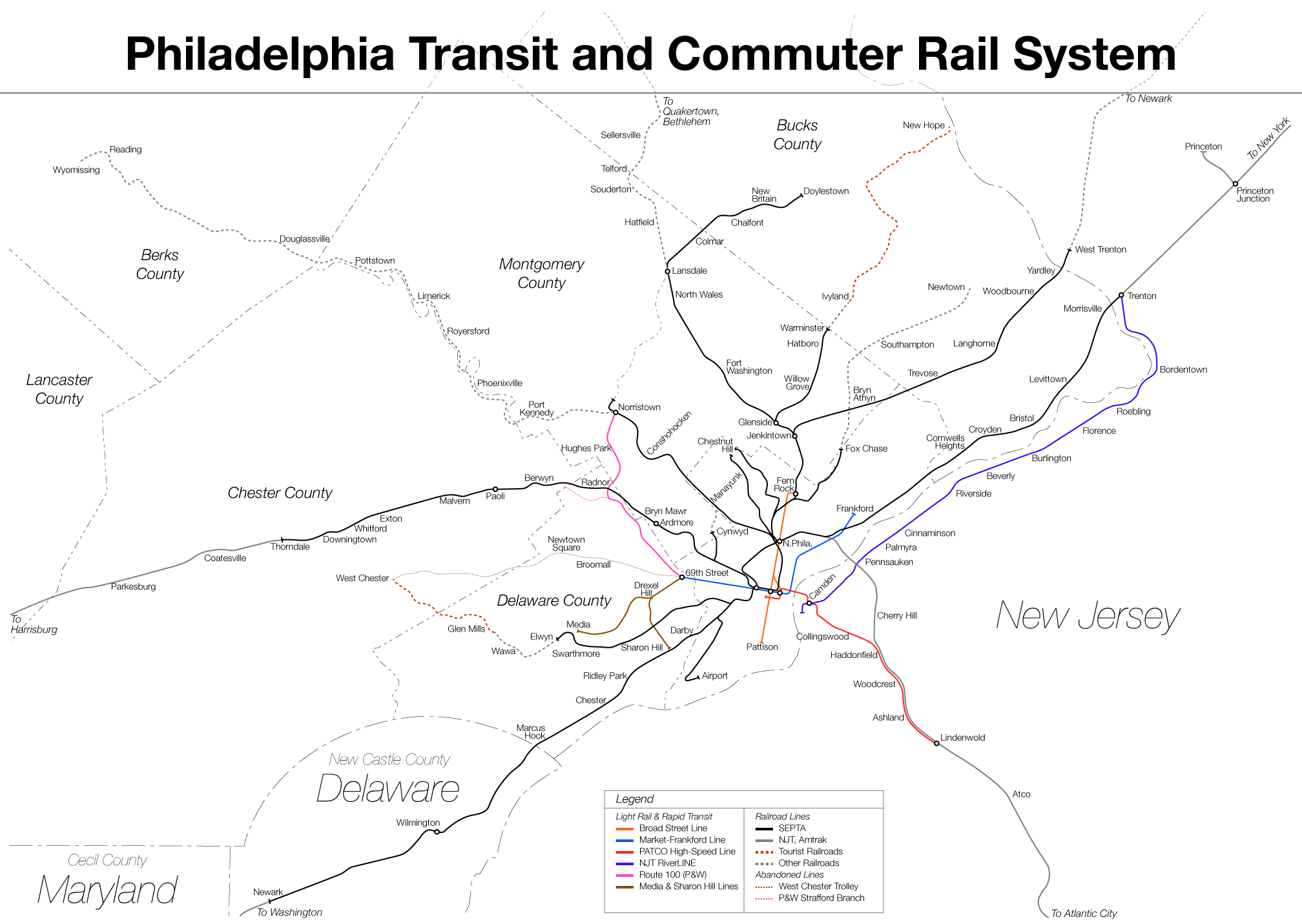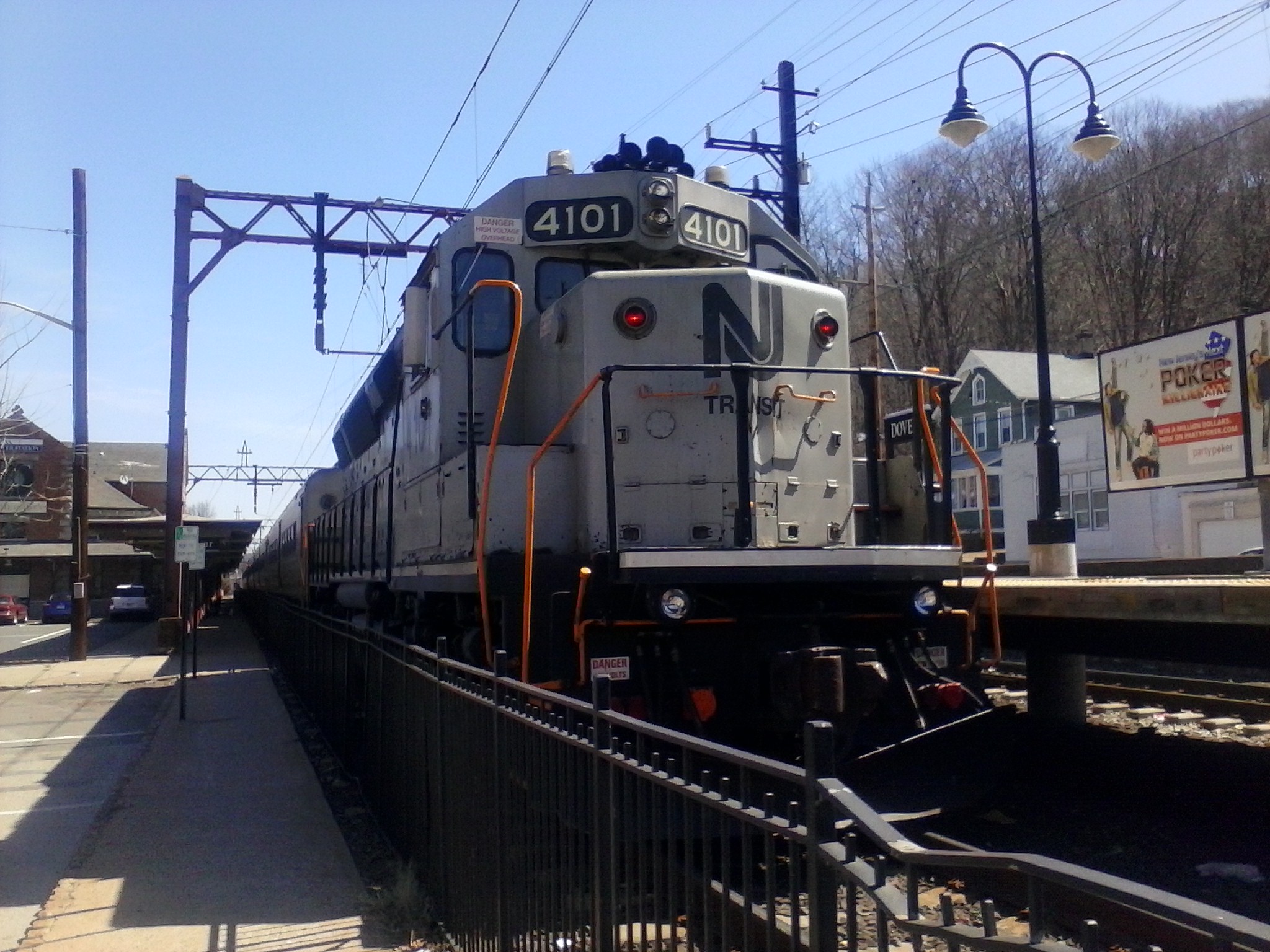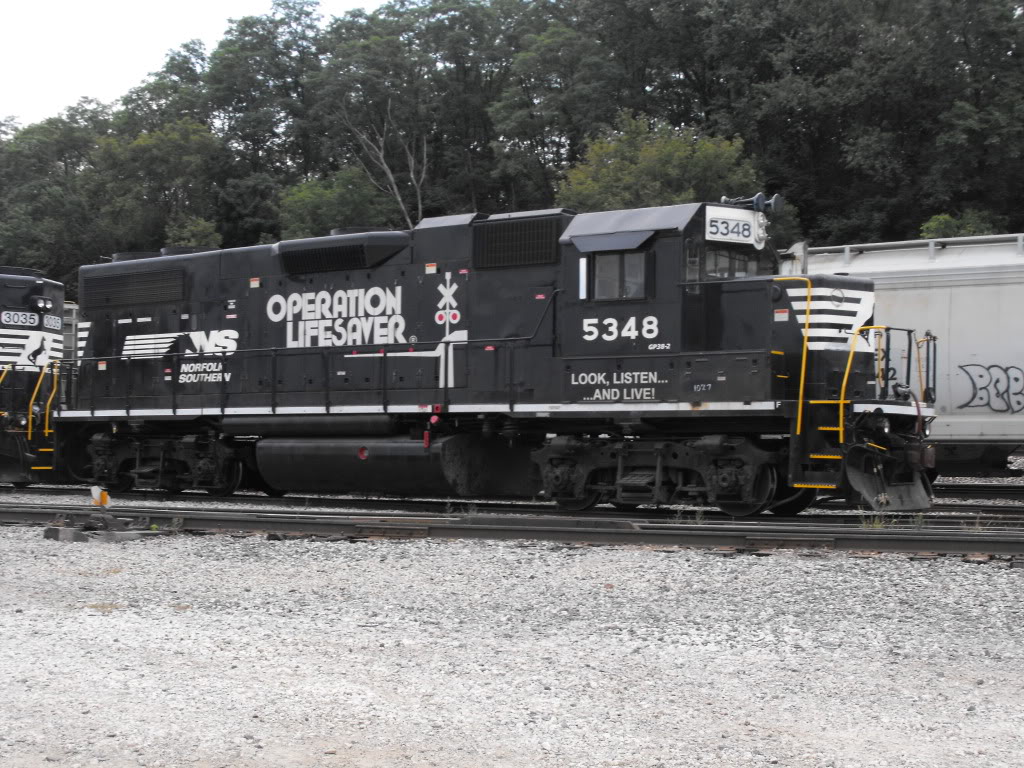|
Silverliner IV
The Silverliner IV is the fourth-generation electric multiple unit railcar in the Silverliner family. It was designed and built by General Electric and was delivered between 1973 and 1976. It operates on the SEPTA Regional Rail network throughout Greater Philadelphia. The 232-car Silverliner IV order was the largest order of the Silverliner series to date. It allowed for the retirement of most of the Reading electric multiple units and PRR MP54 cars, which dated from at least the 1930s. Three times as numerous as the previous Silverliner trains put together, the Silverliner IV became SEPTA's most common passenger railcar from 1976 onward. Like the Silverliner II and III cars, the IV cars were owned by SEPTA and provided to the private railroads for use in their state-supported commuter rail operations until SEPTA assumed direct operation in 1983. Features The cars were ordered from General Electric and Avco. Aside from the boxier look and smaller side windows, the main chang ... [...More Info...] [...Related Items...] OR: [Wikipedia] [Google] [Baidu] |
Silverliner
Silverliner is the name given to a series of electric multiple unit (EMU) railcars in commuter rail service in the Philadelphia area since 1958. As of the introduction of the Silverliner V in 2009–2010, there have been 5 generations of Silverliner cars, identified by the Roman numerals I through V placed after the name Silverliner. The Silverliner name came from the classes' shiny stainless steel body shell, which contrasted with the painted and frequently rusting carbon steel railcars used by the Pennsylvania and Reading Railroads between 1915 and 1936. Applied to the first large production order in 1963, the cars made such an impression that the name has since been applied to all subsequent MU classes purchased by SEPTA for the Regional Rail services. Silverliner I What came to be known as the Silverliner Is were a set of 6 pilot EMUs making use of Budd's prototype Pioneer III railcar design. The 6 Pioneer III cars were purchased in response to the increasing ... [...More Info...] [...Related Items...] OR: [Wikipedia] [Google] [Baidu] |
SEPTA Regional Rail
The SEPTA Regional Rail system is a commuter rail network owned by the Southeastern Pennsylvania Transportation Authority and serving the Philadelphia Metropolitan area. The system has 13 branches and more than 150 active stations in Philadelphia, Pennsylvania, its suburbs and satellite towns and cities. It is the fifth-busiest commuter railroad in the United States, and the busiest outside of the New York and Chicago metropolitan areas. In 2016, the Regional Rail system had an average of 132,000 daily riders and 118,800 daily riders (As of 2019). The core of the Regional Rail system is the Center City Commuter Connection, a tunnel linking three Center City stations: the above-ground upper level of 30th Street Station, the underground Suburban Station, and Jefferson Station (formerly Market East Station). All trains stop at these Center City stations; most also stop at Temple University station on the campus of Temple University in North Philadelphia. Operations are ... [...More Info...] [...Related Items...] OR: [Wikipedia] [Google] [Baidu] |
Fern Rock Transportation Center
The Fern Rock Transportation Center is a SEPTA rail and bus station located at 10th Street and Nedro Avenue in the Fern Rock neighborhood of Philadelphia, Pennsylvania. Fern Rock serves as the northern terminus and yard for SEPTA's Broad Street Line, as well as a stop for SEPTA Regional Rail's Lansdale/Doylestown Line, Warminster Line, and West Trenton Line. Four bus routes also serve the station. Fern Rock Transportation Center serves as the western terminus for the 28 and 70 bus routes. Fern Rock is also the northernmost terminus for the 4 and 57 bus routes. Regional Rail platforms Fern Rock Transportation Center serves the Warminster Line, West Trenton Line, and the Lansdale/Doylestown Line. In FY 2015, there was a weekday average of 825 boardings and 792 alightings. The current SEPTA Regional Rail station at Fern Rock Transportation Center, located along the SEPTA Main Line, was built in March 1992 to accommodate Regional Rail commuters displaced during SEPTA's 199 ... [...More Info...] [...Related Items...] OR: [Wikipedia] [Google] [Baidu] |
WABCO N-Type
A coupling (or a coupler) is a mechanism typically placed at each end of a railway vehicle that connects them together to form a train. A variety of coupler types have been developed over the course of railway history. Key issues in their design include strength, reliability, ease of making connections and operator safety. The equipment that connects the couplings to the vehicles is the draft gear or draw gear and these must absorb the stresses of coupling and train acceleration. Nomenclature Compatible and similar couplings or couplers are frequently referred to using widely differing make, brand, or regional names, or nicknames, which can make describing standard or typical designs confusing. Dimensions and ratings noted in these articles are usually of nominal or typical components and systems, though standards and practices also vary widely with railway, region, and era. Buffers and chain The basic type of coupling on railways following the British tradition is the b ... [...More Info...] [...Related Items...] OR: [Wikipedia] [Google] [Baidu] |
PCBs
Polychlorinated biphenyls (PCBs) are highly carcinogenic chemical compounds, formerly used in industrial and consumer products, whose production was banned in the United States by the Toxic Substances Control Act in 1979 and internationally by the Stockholm Convention on Persistent Organic Pollutants in 2001. They are organic chlorine compounds with the formula C12 H10−''x'' Cl''x''; they were once widely used in the manufacture of carbonless copy paper, as heat transfer fluids, and as dielectric and coolant fluids for electrical equipment. Because of their longevity, PCBs are still widely in use, even though their manufacture has declined drastically since the 1960s, when a host of problems were identified. With the discovery of PCBs' environmental toxicity, and classification as persistent organic pollutants, their production was banned by United States federal law in 1978, and by the Stockholm Convention on Persistent Organic Pollutants in 2001. The International Agen ... [...More Info...] [...Related Items...] OR: [Wikipedia] [Google] [Baidu] |
Silicon Controlled Rectifier
A silicon controlled rectifier or semiconductor controlled rectifier is a four-layer solid-state current-controlling device. The name "silicon controlled rectifier" is General Electric's trade name for a type of thyristor. The principle of four-layer p–n–p–n switching was developed by Moll, Tanenbaum, Goldey, and Holonyak of Bell Laboratories in 1956. The practical demonstration of silicon controlled switching and detailed theoretical behavior of a device in agreement with the experimental results was presented by Dr Ian M. Mackintosh of Bell Laboratories in January 1958. The SCR was developed by a team of power engineers led by Gordon Hall and commercialized by Frank W. "Bill" Gutzwiller in 1957. Some sources define silicon-controlled rectifiers and thyristors as synonymous while other sources define silicon-controlled rectifiers as a proper subset of the set of thyristors; the latter being devices with at least four layers of alternating n- and p-type material. Acco ... [...More Info...] [...Related Items...] OR: [Wikipedia] [Google] [Baidu] |
SEPTA GE Silverliner IV SPAX313
The Southeastern Pennsylvania Transportation Authority (SEPTA) is a regional public transportation authority that operates bus, rapid transit, commuter rail, light rail, and electric trolleybus services for nearly 4 million people in five counties in and around Philadelphia, Pennsylvania. It also manages projects that maintain, replace and expand its infrastructure, facilities and vehicles. SEPTA is the major transit provider for Philadelphia and the counties of Delaware, Montgomery, Bucks, and Chester. It is a state-created authority, with the majority of its board appointed by the five Pennsylvania counties it serves. While several SEPTA commuter rail lines terminate in the nearby states of Delaware and New Jersey, additional service to Philadelphia from those states is provided by other agencies: the PATCO Speedline from Camden County, New Jersey is run by the Delaware River Port Authority, a bi-state agency; NJ Transit operates many bus lines and a commuter ra ... [...More Info...] [...Related Items...] OR: [Wikipedia] [Google] [Baidu] |
New Jersey Department Of Transportation
The New Jersey Department of Transportation (NJDOT) is the agency responsible for transportation issues and policy in New Jersey, including maintaining and operating the state's highway and public road system, planning and developing transportation policy, and assisting with rail, freight, and intermodal transportation issues. It is headed by the Commissioner of Transportation. The present Commissioner is Diane Gutierrez-Scaccetti. History The agency that became NJDOT began as the New Jersey State Highway Department (NJSHD) circa 1920. NJDOT was established in 1966 as the first State transportation agency in the United States. The Transportation Act of 1966 (Chapter 301, Public Laws, 1966) established the NJDOT on December 12, 1966. Since the late 1970s, NJDOT has been phasing out or modifying many list of traffic circles in New Jersey, traffic circles in New Jersey. In 1979, with the establishment of New Jersey Transit, NJDOT's rail division, which funded and supported State-s ... [...More Info...] [...Related Items...] OR: [Wikipedia] [Google] [Baidu] |
Arrow (railcar)
The Jersey Arrow is a type of electric multiple unit (EMU) railcar developed for the Pennsylvania Railroad, and used through successive commuter operators in New Jersey, through to NJ Transit. Three models were built, but only the third model is in use today. The series is similar to SEPTA's Silverliner series, but include center doors among other differences in details. Arrow I The first series of Arrows (classed MA-1A or PRR MP85E6) were built in 1968-69 by the St. Louis Car Company; 35 were built and purchased by the New Jersey Department of Transportation (NJDOT). These cars were initially numbered 100–134. These cars were built with higher capacity 3-2 seating which caused grumbling by the passengers at that time. In 1966 the NJDOT ordered 35 PRR "MP85" class MU cars from St. Louis Car for high speed service between New York and Trenton with a design based on the SEPTA/PSIC (Passenger Service Improvement Corporation) Silverliner III units then under order from St. Loui ... [...More Info...] [...Related Items...] OR: [Wikipedia] [Google] [Baidu] |
New Jersey Transit Rail Operations
NJ Transit Rail Operations is the rail division of NJ Transit. It operates commuter rail service in New Jersey, with most service centered on transportation to and from New York City, Hoboken, and Newark. NJ Transit also operates rail service in Orange and Rockland counties in New York under contract to Metro-North Railroad. The commuter rail lines saw riders in , making it the second-busiest commuter railroad in North America as well as the longest by route length. This does not include NJ Transit's light rail operations. Network and infrastructure The lines operated by NJ Transit were formerly operated by the Pennsylvania Railroad, Central Railroad of New Jersey, New York and Long Branch Railroad and Erie Lackawanna Railroad, most of which date from the mid-19th century. From the 1960s onward, the New Jersey Department of Transportation began subsidizing the commuter lines. By 1976, the lines were all operated by Conrail under contract to NJDOT. The system took its ... [...More Info...] [...Related Items...] OR: [Wikipedia] [Google] [Baidu] |
Married Pair
A twin unit or twinset is a set of two railroad cars or locomotives which are permanently coupled and treated as if they were a single unit. A twinset of cars or coaches can also be called a twin car. In US passenger railroad parlance, twin units are also known as married pairs. On passenger railroads, light rail, and monorail services, married pairs may have machinery necessary for full operation of the cars split between them. Items that are typically shared include transformers, motor controllers, dynamic braking grids, cabs, current collectors, batteries, and air compressors. This provides significant savings in both cost of equipment and weight, which increases performance and decreases energy consumption. The cost of operating such a pair may be slightly higher when the extra car in such a pair is not needed to meet level-of-service demands at a particular time. See also * Cow-calf * Multiple unit A multiple-unit train or simply multiple unit (MU) is a self-p ... [...More Info...] [...Related Items...] OR: [Wikipedia] [Google] [Baidu] |
Dynamic Brake
Dynamic braking is the use of an electric traction motor as a generator when slowing a vehicle such as an electric or diesel-electric locomotive. It is termed " rheostatic" if the generated electrical power is dissipated as heat in brake grid resistors, and " regenerative" if the power is returned to the supply line. Dynamic braking reduces wear on friction-based braking components, and regeneration lowers net energy consumption. Dynamic braking may also be used on railcars with multiple units, light rail vehicles, electric trams, trolleybuses, and electric and hybrid electric automobiles. Principle of operation Converting electrical energy to the mechanical energy of a rotating shaft (electric motor) is the inverse of converting the mechanical energy of a rotating shaft to electrical energy (electric generator). Both are accomplished through the interactions of armature windings with a (relatively) moving external magnetic field, with the armature connected to an elec ... [...More Info...] [...Related Items...] OR: [Wikipedia] [Google] [Baidu] |







